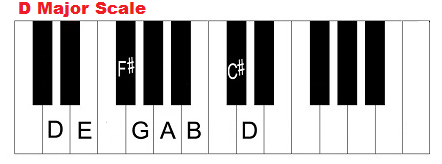Chords are where it’s at. They’re the foundation for all popular songs, but it can be hard to know how to practice chords. So this lesson will show you the best way to practice chords (in my opinion).
The common problem with practicing chords is that it can get kinda … boring.
This routine will show you a way to practice chords that’s enjoyable, interesting, and useful! You’ll be learning stuff you can use in real songs.
And it’s as easy as 3 steps.
I can’t emphasize how important this is. If you don’t know your key signature you won’t be able to figure out what chords to practice.
So pick a key signature you know (this routine is the best way to practice chords, not the best way to learn new key signatures) 🙂
For this example, we’ll use the key of D major. D has 2 sharps (F# and C#) and looks like this:

Here’s where things get fun.
The Claw exercise will teach you every chord that is in the key of D. These are called “diatonic chords”. And it’s the best way to learn what chords go together.
Here’s how it works.
Start by putting your thumb on D, then skip a note (E) and play the next one. But remember! There is an F# in the key of D, so instead of playing the F, we play the F# with our middle finger. Then skip another note (G) and play the A with our pinky.

This is the “Claw” shape, and it’s the shape we are going to keep as we play chords up and down the scale.
Start slowly, but your goal is to build up to a decent speed with both hands, like this:
That’s the solid form of the Claw. The next step is to play these as broken chords up and down the scale.
As you do, try naming each chord you’re playing. This will help you get used to identifying the chords quickly so when you see them on a piece of music you’ll know straight away what they are.
You’ve now established what chords are in the key of D and you’ve practiced playing them so they feel like second nature.
Now we’re going to have some fun. This is where the practice gets musical and applicable to playing popular songs, and it’s why I really think this is the best way to practice chords.
We know that the chords of D major should sound good together, so we can start mixing and matching chords within the key of D to discover what progressions sound good.
You might start with D, then play Bm, then G. The choice is yours! You can experiment starting on different chords and playing different progressions.
As you do this, you’ll probably stumble across some of the most popular pop chord progressions.
This routine should take you about 10-15 minutes. Don’t spend any longer on it than that. Do what you can in that time and then leave it until tomorrow.
But after you have done it once, there are many ways to keep progressing and developing your skills so you see results.
For example, if you only used root position chords in one practice, try using inversions the next time to practice. Start just by adding the 1st inversion.
Or you could work on improving the speed with which you can play the Claw up and down the keys.
Or, choose a key signature you’re not as comfortable with.
There are so many options that it’s really hard to get bored. I mean, it should be if I’m going to call it the best way to practice chords 😉
Happy practicing!
Lisa Witt has been teaching piano for more than 20 years and in that time has helped hundreds of students learn to play the songs they love. Lisa received classical piano training through the Royal Conservatory of Music, but she has since embraced popular music and playing by ear in order to accompany herself and others. Learn more about Lisa.
/marketing/pianote/promos/april/banner-bg-m.webp)
We use cookies for traffic data and advertising. Cookie Policy »
/marketing/pianote/promos/april/banner-title.webp)